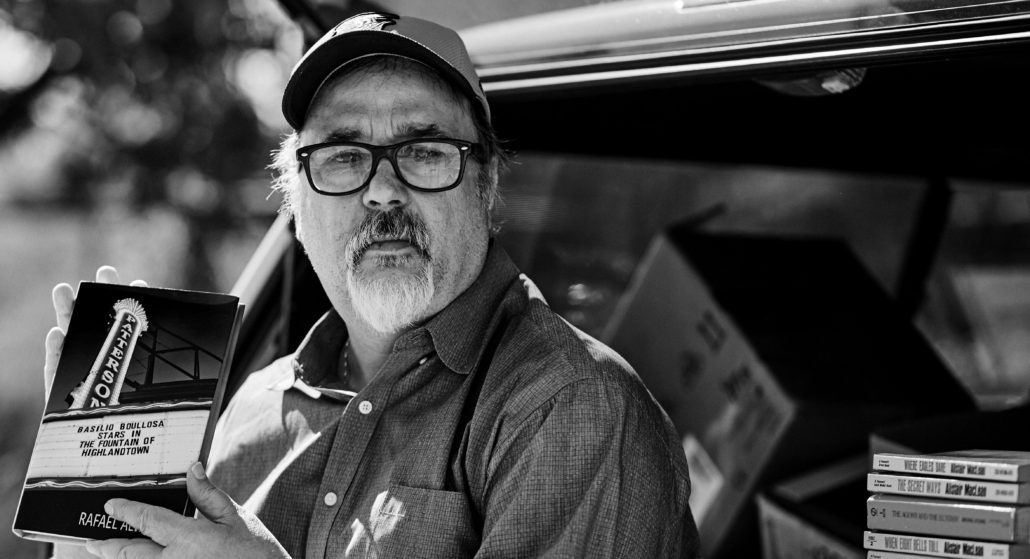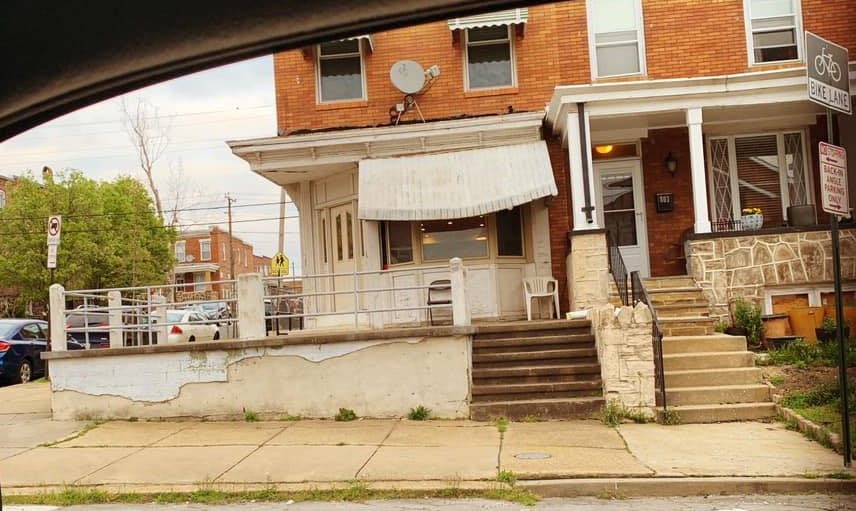Photo by Sean Schiedt
Lives in the Balance
A Review of Rafael Alvarez’s Basilio Boullosa Stars in the Fountain of Highlandtown
by Sue Mach / June 2018
“How many sins could you commit in one day and still tell yourself you were a good man?” After skipping a traditional Christmas Eve dinner and screwing up an untraditional one he was supposed to be having with his girlfriend, the character of Wigmann contemplates this question as he downs a liver and onion dinner at a Baltimore harbor-side bar while thumbing through passages of The Diary of Anne Frank, deciding whether or not he will go to the pier, upon his mother’s request, to pick up a visiting Spaniard from the Old Country. All of the themes of Rafael Alvarez’s evocative collection of short stories, Basilio Boullosa Stars in the Fountain of Highlandtown, coalesce in this moment. The question of goodness and the search for beauty are underlying currents throughout these stories.
Wigmann is a featured player in the first story, “I Know Why I Was Born,” which begins on the day that our star, Basilio, (age eight) wakes up and realizes he was “[b]orn to paint the pictures in his head, to sketch the kitchen in the basement, to capture the clouds as the wind drove them past the bottle cap factory down by the railroad tracks, to capture the air that swirled across the tarred rooftops.” The stories are roughly chronological and follow Basilio from his artistic awakening to his free-fall from a scaffold while painting a mural, “a plunging pint of Hellenic blue about to mix with the thin blood of an 86-year-old artist who’d never received his due.”
While Baltimore is his canvas, Basilio’s chorography is the soul. The book was published on the twentieth anniversary of Alvarez’s first short story collection, The Fountain of Highlandtown, and the short story from which the collection bears its name appears in both books. Reading the story a second time in a different context is a unique experience because now we know Basilio as a middle-aged man who, in both his paintings and his life, is simply trying to get things right. Divorced and out of a “real job,” he moves from the suburbs to Macon Street to live with his Spanish grandfather. “Why are you here?” the old man asks almost daily. It’s a question that never escapes the artist.
Art, for Basilio, is a way to capture the past and still the motion of constant change in which rituals and traditions are turned upside down. For instance, not long after his divorce, Basilio fake-marries a woman in an Elvis bar where they fish their rings from a tank of abandoned wedding bands. The truest moment of the story is when the woman, Roxanne, literally bears her breasts and asks him to paint her.
Basilio’s great obsession is his distant cousin, Nieves, “…both kin and stranger, all of nineteen years old,” who arrives unannounced from Spain to live with him and his grandfather in an attempt to escape a drug addiction. For Basilio, Nieves brings “[a] sense of being in Spain though he’d never been, a transcendence of time and place he tried to understand but never felt from the stories he’d heard from Grandpop all his life, the stories he’d begun to paint after moving in.” Basilio abandons all common sense; instead he tries to discover Nieves by painting and sketching her. In the end, not unlike the genetic memory of a past he will never know, she becomes lost to him—both literally and figuratively, after she’s arrested for shooting heroin. She leaves the house and folds into the city. Neither Basilio nor this American Jerusalem can save her.
Alvarez is a kind of urban Proust, favoring pickled pig’s feet over madeleines, and baseball stadiums in lieu of French drawing rooms, all underscored by a rock and roll soundtrack. Things fall apart. A sober Basilio arrives too late in the eighth inning of an Orioles game in an attempt to reconcile with his wife. Expressways plow through immigrant neighborhoods. In order to get his daughter access to private Catholic education, Basilio makes a deal with a beer drinking nun to restore paintings in a church and school that will vanish the following year. Still, from the rubble comes some kind of rebirth, and the artists—both Basilio and Alvarez—bear witness. These stories strike a profound balance between motion and stillness, the sacred and the profane—the tension of which achieves the beauty they seek.
Review: Basilio Boullosa Stars in the Fountain of Highlandtown
Reviewed by Joseph Crespo
“Elvis took ‘obey’ out of the vows but only if Priscilla dyed her hair black and piled it up high in a beehive. Just like the old ladies up in Highlandtown.”
“Highlandtown?”
“The Holy Land,” said Basilio.”
The collection of short stories by Rafael Alvarez, Basilio Boullosa Stars in the Fountain of Highlandtown, is a sort of update to the author’s canon. The book is named for the story at its center, which is the original gem from a previous collection about Baltimore (The Fountain of Highlandtown), whose other stories the author essentially renounces in his Forward.
The author’s chosen time and place are an interesting case of the great hangover that American cities experienced after the rush of the post-WWII economic boom. This case concerns an east coast, port city that sits just off the mouth of one of those characteristically wide, Tidewater rivers. This is the principal city of that grand estuary called the Chesapeake that allows anyone to precisely locate our odd, little state of Maryland on the crudest map or smallest globe. As in many cities, the story was enacted where the second generation saw the icons of the first generation’s prosperity dismantled. The factories closed down while the communities that surrounded them persisted. Basilio Boullosa’s city thrived on steel manufacturing and lived to see its decline. but these stories are a different kind of testimony. They effectively convey the experiences of Basilio’s community, but they are from a young baby boomer’s perspective. It’s a little different than the familiar small-town-in-decline stories with which I grew up. It’s an immigrant neighborhood whose younger generation scatters away from it, all except Basilio, who returns to it from the county and won’t let go. This is a refreshing perspective on a topic that gets a lot of treatment because it deserves so much. Paying tribute to the 20th Century’s rise by narrating its fall is a tradition that Alvarez is well-suited to honor. The life of Basilio Boullosa is a realm of memory.
This life is laid bare for us in these stories. Basilio is living with Grandpop, an old Spaniard, in the house on Macon Street. With some memories of his childhood as the exception, we only see his life post-divorce, whether it’s from his perspective or one of the other Holy Land denizens. It is interesting to note that only in the title story does the author share Basilio’s perspective in the first-person. He shares other first-person perspectives with us, each with its own vantage point of the Holy Land and of Basilio, but The Fountain of Highlandtown is the center of gravity that draws all of these other tales together. Perhaps the author can stand to bare his fictional counterpart’s thoughts directly here because he goes to such sincere effort to portray two other voices: Grandpop, and the Johns Hopkins doctor named Katherine who decides to let the odd painter she met at the market take her on a date.
Although this book is not a novel, it accomplishes for Basilio and the Holy Land what a novel could, but with a degree of freedom that the novelist doesn’t necessarily enjoy. Katherine is a strong enough character to have determined the arc of the entire book, but the story-writer is not obligated to repeat his cast of characters. Some tales meander through memories as though they had willed themselves into a form that would be included in this time capsule. Other stories, such as “Nine Innings in Baltimore,” are highly-organized and crucial to the arc of Basilio’s life.
We see the cleverness of the writer from the beginning. He doesn’t show us Basilio the divorcé right away. He begins by showing us a lonely fellow called Wigmann, whose life touches that of young Basilio back when Grandpop was not so grouchy. Alvarez has a green thumb for planting single seeds in the places where they must grow. We learn here that, no matter what, Grandpop loves Basilio. A critic could almost wonder what the point of Wigmann is, since we don’t get a feel for him so much as an outline, but the outline is adequate to house the foreshadowing of what Basilio’s woes will one day be. It’s almost too much – the first story of the anthology has us waist-deep in characters and their pasts and their feelings. “Orlo remembered when he was Wigmann’s age, it was the year Leini got married, a year into their affair. He’d sat brooding on the roof of the Salvage House as his lover’s wedding guests danced in a circle behind Ralph’s Diner.” But this crowd of details has charm not unlike the charm of Miss Bonnie’s bar, stacked up to the rafters with Elvis memorabilia, including a “one-hundred-gallon home of a submerged Graceland and three generations of Holy Rosary Spring Carnival goldfish floating in and out of the mansion’s empty rooms, the path to the King’s front door paved with bands of gold.” Alvarez’s fiction functions in this way. It simmers with memory continuously, like Orlo’s “cauldron of trotters.” At the end of Wigmann’s story, we see the intersection of the two characters that reveals why Wigmann’s story has to be included. The reader can’t help but feel set up for a punchline.
A continual point of interest for the reviewer is Basilio’s portrayal as a painter. One cannot help but wonder about process when an author is writing autofiction. One wonders what is autobiographical and what is ficto-nautical. A reference to felt-tip Faber-Castels is appreciated, and the notion of the narrator, whose voice we know from the hearing Aunt Lola on the radio, as having earned his Christmas money painting crabs on the sides of trucks is positively adorable, but writing a character who is an artist is a formidable feat. I had to wonder at least a bit how much the author might actually draw. Even if he never painted a blue crab, perhaps he found himself “sketching the altar linens” at his own mother’s funeral. It is a meaningful image. I spent the earlier section of this anthology wondering about how convincing a painter Basilio was, all the way until the moment Basilio described his attempt to paint Bolewicki’s clock. “I couldn’t get the water right, I couldn’t make it look like it was really bubbling.” It was not a moment too soon. The moment Basilio the painter is granted at the end of the title story is significant and well-earned, and clearly serves as an impetus to the formation of all the other stories around this one.
Every exploration the author makes is a chance to adorn the narrative with a profundity of detail and history. “Nine Innings in Baltimore” comes in the collection’s second half, and it features a moment when Basilio is greatly troubled, having already “banged the heavy receiver of Grandpop’s rotary phone – black steel and Bakelite, Eastern 7-5254 – against the kitchen wall, chipping the plaster…” He is out, pounding the pavement in a desperate state, but still, the author can’t help but perceive history at every angle. “Basilio veered off the tracks, passed the ruins of the Standard Oil refinery (back in the 1940s, his mother’s grandfather had lost a foot there), and scuffled through the side streets and alleys toward Miss Bonnie’s bar on the edge of the gentrified harbor.” This setting is saturated with its time and place. This story is carefully structured across the nine innings of an Orioles game that Basilio doesn’t quite attend. Careful, writerly choices are made possible by this that allow Alvarez to set the reader up yet again for a patiently delivered punchline that turns out to ripple throughout the rest of the book. At the same time, the reviewer couldn’t help but feel that a well-ordered structure wasn’t all that was necessary. The miasmic, frenetic meandering that is the story of “Basilio and Grandpop and Nieves” comes just before “Nine Innings” and serves as its nonsensical opposite. If Basilio’s identity as a painter is fueled by the author’s head full of pictures, then the “Nieves” story is from the place those pictures go to swirl and storm around in the author’s head, less a memory of Highlandtown and more a fever dream of a “familiar cloven hoof hard on the pedal from the moment he met her at the storm door embossed with an aluminum ‘B.’” A consequential tale like “Nine Innings” could only function properly with a broad emotional basis for it established. Perhaps only an inexplicable chaos like the “Nieves” story could supply that.
All spoilers aside, the second half of the anthology follows the further growth of this human being called Basilio Boullosa, whose life does not take place exclusively within the boundaries of the Holy Land. Timewise, we are with him through the demolition of Memorial Stadium, the old home of the Baltimore Orioles. His life is our time capsule, having captured so much soul and character from the city he loves. The 21st Century is distinguishing itself according to values not held precious by all would-be ambassadors of the past. Alvarez makes for a conscientious storyteller. He doesn’t go so far as to address the segregation of the times, but the charm of his tales and the triumphs of his characters in no way depend on exclusion or disparagement of other races, creeds, or nationalities. The author seems to bare his heart without betraying any ugly prejudices. Inasmuch as a male reviewer may comment on a male author’s representation of women, Alvarez appears to hold himself to a standard of respect. It seems relevant to mention, because current times have seen sexist behaviors that were once commonplace and accepted called out and summarily rejected, to the extent that they take on a sort of musty odor, an old century-ness that can no longer serve. Of course, the 20th Century was still grand, and full of poetic history – it simply required capable, 21st Century ambassadors to share its treasures.
-Joseph Crespo





